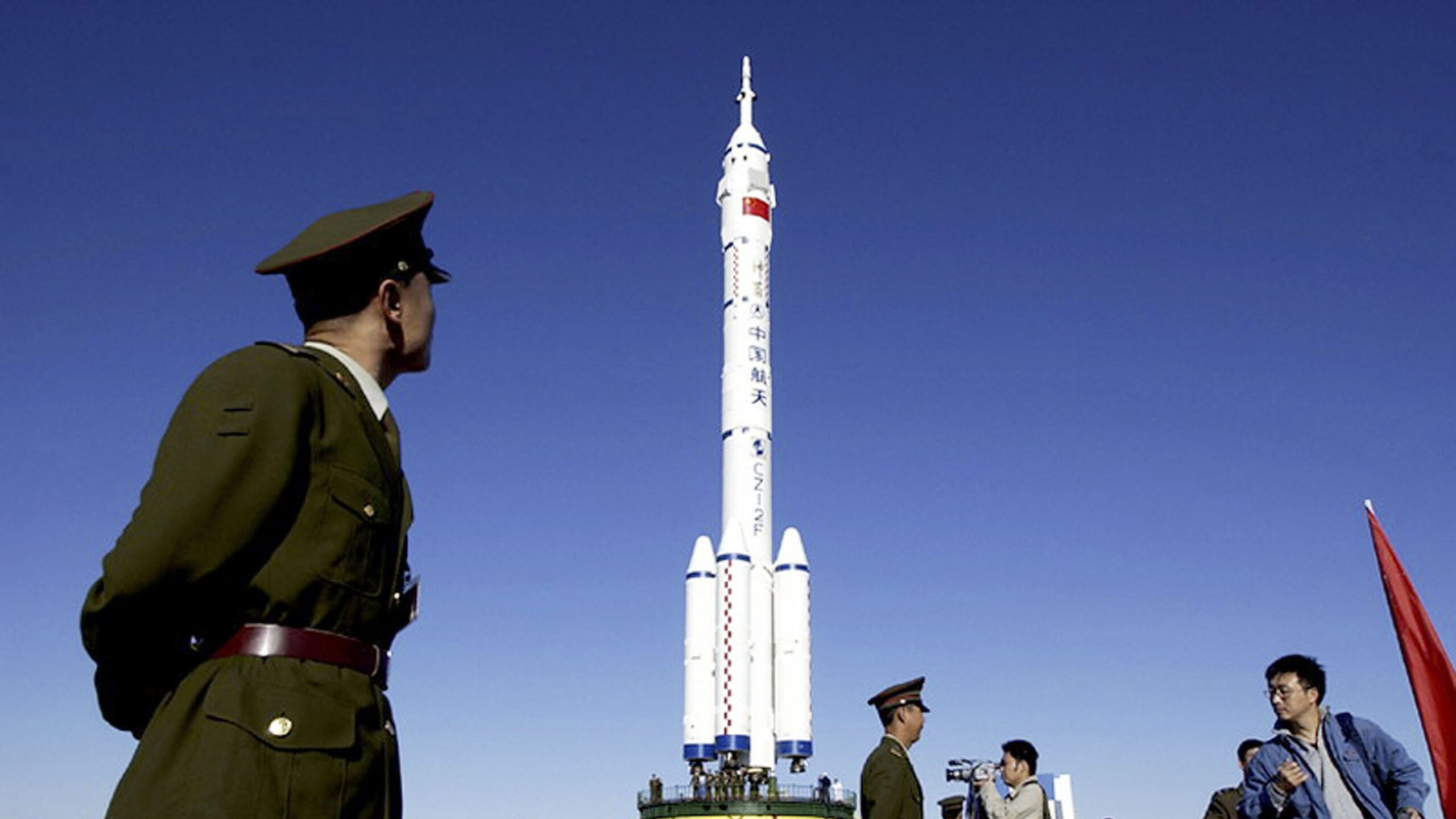
Military soldiers stand guard as the Shenzhou VI spacecraft, sitting atop of the LM-2F carrier rocket, is moved towards the launching pad in Jiuquan Satellite Launch Center on October 7, 2005 in Jiuquan of Gansu Province, northwest China. (China Photos/Getty Images)
WASHINGTON: The Biden administration’s new Indo-Pacific strategy calls for deepening regional security partnerships, closer collaboration with allies on emerging technologies, and expanding American 5G and cyber capabilities across the region, all in order to counter China.
If that all sounds familiar, that’s because it is.
“Our collective efforts over the next decade will determine whether the PRC [People’s Republic of China] succeeds in transforming the rules and norms that have benefitted the Indo-Pacific and the world,” the strategy states.
“Our objective is not to change China but to shape the strategic environment in which it operates, building a balance of influence in the world that is maximally favorable to the United States, our allies and partners, and the interests and values we share.”
In a phone call with reporters, a senior administration official noted that the goal of the strategy was not to contribute to an atmosphere that leads to conflict with China or to force nations in the region to “take sides,” but rather to “[blunt] Beijing’s efforts to frustrate US objectives.”
In that sense, the new strategy is not much different than the Trump administration’s own vision for the region, which was released in 2019. At the heart of both documents are concerns about Chinese aggression, including mounting pressure on Taiwan.
The main differences come in the form of the Biden administration’s interest in climate change — an “existential” crisis and one of the areas where the administration expresses a desire to work with China — and its desire to foster economic growth and supply chain resiliency after the COVID-19 pandemic.
The Biden administration strategy lays out five lines of effort. Most relevant for those in the defense space is the goal to bolster security in the region.
“Integrated deterrence will be the cornerstone of our approach,” the document states. “We will more tightly integrate our efforts across warfighting domains and the spectrum of conflict to ensure that the United States, alongside our allies and partners, can dissuade or defeat aggression in any form or domain. We will drive initiatives that reinforce deterrence and counter coercion, such as opposing efforts to alter territorial boundaries or undermine the rights of sovereign nations at sea.”
The strategy restates the US’s commitment to creating innovative new tech in areas like space and cyber, while also taking steps to make command and control more resilient, allowing troops to operate forward in a contested environment.
It also expresses interest in “finding new opportunities to link our defense industrial bases, integrating our defense supply chains, and co-producing key technologies that will shore up our collective military advantages.”
Another major priority is to increase prosperity in the region. The Biden administration plans to put out an Indo-Pacific economic framework early this year that will facilitate trade, improve supply chain resiliency and build infrastructure and digital connectivity.
Specifically, the administration hopes to expand American infrastructure projects in the region, providing “open, resilient, secure, trustworthy tech” that includes including 5G, Open Radio Access Network and cyber technologies, the administration official said. Those capabilities could provide direct competition to Chinese 5G providers such as Hwawei.
Other lines of effort include:
- Advancing a “free and open Pacific,” ensuring that countries in the region can independently govern themselves without coercion from other actors and that international laws pertaining to the maritime and air domain are respected.
- Forging connections with countries in the region — through mechanisms like that Association of Southeast Asian Nations or the Quadrilateral Security Dialogue — as well as helping forge relationships between Indo-Pacific nations and outside organizations like NATO and the European Union.
- Building “resilience” in the face of transnational crises such as climate change and the COVID-19 pandemic. The strategy specifically notes that the US will urge China “to commit to and implement actions in line with the level of ambition required to limit [global] warming to 1.5 degrees Celsius.”
For all the Biden administration’s plans for focus on the pacific, however, it is impossible to ignore that this new strategy was rolled out at the same time that National Security Advisor Jake Sullivan held a press conference warning that Russia could invade Ukraine at any moment, and telling Americans they need to get out of the country in the next 48 hours.
Whether this strategy will bear success, or become one more symbol of America’s perennial inability to focus on the pacific, remains to be seen.
Iran says it shot down Israel’s attack. Here’s what air defense systems it might have used.
Tehran has been increasingly public about its air defense capabilities, including showing off models of systems at a recent international defense expo.


























